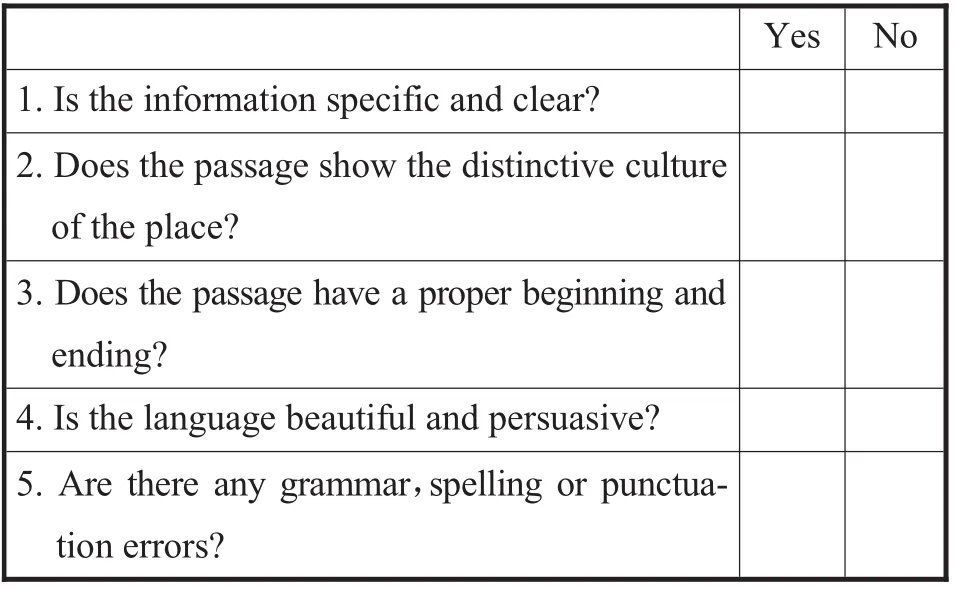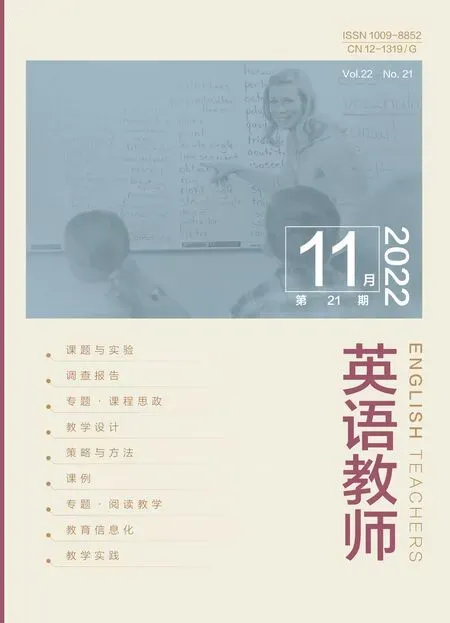大观念引领下的教学设计
——以Unit 3 Diverse Cultures Reading for Writing为例
高兴萍
引言
人教版高中英语新教材每个单元的编写均以鲜明的主题为引领,每个单元的内容均从不同角度体现学科育人价值。因此,教师在备课时要深入研读教材和教参,挖掘单元的育人价值,确定单元教学的大观念。大观念是一个相对的概念,只要能分解出更小概念的观念,都可称作为大观念。“大观念是学生完成学习后生成的新的认知结构、解决问题的思想和方法,以及价值观念,是可以迁移到新的情境中,用于解决问题的素养,是能够对学生产生深远影响的观念,并会持续影响其品格、品性和行为表现。”(王蔷、周密、蔡铭珂 2021)盛慧晓(2015)认为“大观念是持久的,它们是5年或10年之后当所有的具体的事实性知识全部忘记后,仍然在大脑中剩下的东西,并能用来解决实际生活中遇到的真实问题”。《普通高中英语课程标准(2017年版2020年修订)》指出:“重视以学科大概念为核心,使课程内容结构化,以主题为引领,使课程内容情境化,促进学科核心素养的落实。”(教育部 2020)这里所说的大概念,其本质与前文所述的大观念在内涵上十分契合。“理解与运用大观念体现了一门学科比较重要的学习目标,它代表了一门学科课程目标或学科素养的要求。”(邵朝友、崔允 2017)。
一、教材分析与教学目标
大观念是教学设计的出发点和落脚点。教师可以根据大观念整合教学内容,规划教学活动和评价活动,帮助学生逐步形成大观念,使新课标对学科核心素养的要求落地课堂。英语学科有英语学科总的大观念,每个单元有每个单元的大观念,每个课时有每个课时的大观念,为了便于区分,文中把每个课时的大观念称为小观念。
下面,以人教版高中《英语》必修三Unit 3 Diverse Cultures Reading for Writing为例,探究在大观念的引领下如何进行教学设计。
(一)教材分析
首先,深入研读教材和教参,提炼出本单元的大观念。本单元的主题是“多元文化”。多元文化指在一个社会、国家或民族中存在的多种文化的总称。本单元的语篇主要涉及美国和中国的多元文化现象。教师提炼出本单元的大观念为:理解和尊重文化的多样性,形成开放、包容的性格,增强对本民族文化的认同和文化自信。
Reading for Writing板块的阅读语篇Welcome to Chinatown!是一篇带有旅游宣传性质的介绍性文章,客观介绍了位于美国加利福尼亚州旧金山市的中国城,作者选取了中国城最具代表性的内容,包括居民构成、语言、人们的活动、建筑、商店、饮食等。中国城是美国多元文化的重要组成部分,也是传播中华文化的重要窗口。该板块的活动目标是能够介绍一个有显著文化特征的地方(describe a place with distinctive cultural identity)。课时小观念的提炼要以单元大观念为指导,并促进单元大观念的达成。教师根据单元大观念设定本课时小观念,即理解美国文化的多元性,尊重文化差异,增强对中华民族文化的认同和自豪感。
(二)教学目标
根据单元大观念、课时小观念,以及对教材和学情的分析,将本课时教学目标确定为:
1.To learn the introduction of Chinatown in San Francisco and learn the structure,language style and useful expressions of the text.
2.To write an introduction to your hometown with at least one cultural feature.
3.To further understand the diverse cultures of America and appreciate Chinese culture.
二、教学过程
单元大观念的达成要通过课时小观念的获得逐步实现,而小观念的获得是在不断解决问题的过程中发生的。教师基于单元大观念和课时小观念设计学习理解、应用实践、迁移创新等一系列有层次、有逻辑和有内在关联的学习活动和评价活动,帮助学生在主动参与活动的过程中获得课时小观念。
教学环节一:创设情景
让学生观看一段旧金山唐人街的视频,找出视频中代表中国文化的元素,如Chinese style decorations、Chinese style handicrafts、Chinese tea、Chinese food、porcelain、Chinese costumes、Chinese characters和Chinese style architecture等。
【设计说明】
让学生意识到典型的中国文化元素和美国的多元文化现象。
教学环节二:学习理解类活动
教学活动1:让学生快速阅读文章,并回答以下两个问题。
Q 1:What are the famous tourist sites in the Chinatown of San Francisco?
Ss:Dragon Gate,Tin How Temple,Bank of Canton,and Portsmouth Square.
Q 2:What else can you do there?
Ss:We can explore the interesting sights,experience traditional Chinese culture,go shopping,eat Chinese food,and so on.
【设计说明】
让学生进一步感知与注意中国城典型的中国文化元素和美国的多元文化现象。
教学活动2:归纳与概括文章大意。
让学生快速浏览文章,把文章分为三部分,并归纳出每部分的段落大意。
Part 1(Para.1):Introduction
the general introduction to the Chinatown in San Francisco(including location,features and climate).
Part 2(Paras.2—5):Body
the specific information of the Chinatown.
Para.2:history,ethnic groups,language;
Para.3:tourist attractions,famous figures;
Para.4:stores and goods;
Para.5:food.
Part 3(Para.6):Conclusion
Chinatowns’cultural influence.
【设计说明】
让学生归纳文章的篇章结构和每部分的具体内容,形成结构化知识,并感悟中国城对传播中国文化和体现美国多元文化的重要意义,对中国文化产生自豪感和自信心,并为后面的书面表达作铺垫。
教学环节三:语言知识学习
让学生从概要介绍、族群、语言、景点、商业、美食、总结等方面在文中找出描述中国城特征的句子,并画出关键短语,学习其语言表达。
General introduction:
1.The Chinatown in San Francisco isthe biggestin America,and alsothe oldest.
2.It isa very popular tourist drawthat receives more visitors each year than even the Golden Gate Bridge.
Ethnic groups and language:
3.The majority of residents in Chinatown are stillethnic Chinese,many of whom donot speak English fluently.
Tourist attractions:
4.Other famous sites includethe Tin How Temple and Bank of Canton,to name but a few.
5.These days,Portsmouth Square is a great place tosee traditional Chinese culture in real life,such as games of Chinese chess,and people practising Tai chi.
Business:
6.The stores in the Chinatownoffer a unique range ofsouvenirs,goods and clothing.
7.All kinds oftraditional Chinese herbal medicinecan be found too,and there are Chinese tea stores,where visitors cantaste and buy varieties of Chinese tea.
Famous food:
8.There isChinese food to suit everyone’s taste,with traditional dishesfrom all over China.
Conclusion:
9.Chinatowns are an important part ofthe diverse cultureof the USA.
10.They allow visitors who have never been to China toexperience traditional Chinese culture first hand.
【设计说明】
让学生在理解文章结构的基础上学习描述地方特色的表达方式,学习语言知识,为后面的书面表达作好语言准备。同时,让学生对中国文化有更深刻的理解,坚定文化自信,并意识到中国城在传播中国文化方面的重要作用。
教学环节四:应用实践类活动
首先,让学生两人一组完成以下任务:
If you are a guide of the Chinatown in San Francisco,please introduce to visitors the Chinatown’s historic and modern situation,ethnic groups,language,tourist attractions,famous food,business and so on.
其次,邀请几个学生上讲台给全体同学介绍中国城。
【设计说明】
通过此活动让学生内化学过的语言知识和文化知识,增强对中国文化的自豪感和文化自信,尊重不同文化,形成开放、兼容并包的态度。
教学环节五:迁移创新类活动
让学生以小组为单位围绕以下问题进行讨论:
Q1:Who are the target readers?
Ss:People who want to experience Chinese culture without going to China.
Q2:What is the writer’s purpose of writing this text?
Ss:Persuade people to experience Chinese culture in Chinatown.
Q3:What tense is used?
Ss:Simple present tense is used in introduction and simple past tense is used when its history is mentioned.
Q4:What Person is used?
Ss:Third person and it mentions visitors many times.
【设计说明】
让学生领悟到这是一篇介绍中国城的宣传性质的文章,并注意这种宣传性语篇的文体特征,从而培养其思维品质,同时为后面的书面表达作好铺垫。
教学环节六:写作
教师在设计写作任务时应以单元大观念和课时小观念为引领,设计贴近学生生活的情景任务。这样,学生才有话可说、有内容可写,才能调动学习积极性。本堂课的写作任务是让学生模仿这篇文章写一篇短文,介绍自己的家乡。
Use what you have learnt to write an introduction to your hometown with at least one cultural feature.
Tips:
1.general introduction;
2.2—3 aspects of the place,including its distinctive cultural features;
3.conclusion.
You can refer to more expressions in exercise 3 on page 33.
·is located in/on
·has a history of...years
·is divided up into
·has a population of
·is...in size
·is home to...ethnic groups
·the most popular/greatest/largest
·popular festivals/foods/tourist sights include...
【设计说明】
所在学校的学生大部分来自福建省福州市,小部分来自周围的县城。因为福州市及周围的县城都有自己的特色和文化特征,所以让学生描述自己的家乡,让他们注意自己身边的中国文化元素,增强文化自信。
教学环节七:教学评价
为了促进教师的教和学生的学,每课时都要进行教学评价,以检测所设计的教学活动是否有效,课时小观念是否达成,能否促进单元大观念的落实,做到教—学—评一体化。
教学活动1:在课堂上,展示某位学生的习作
Fuzhou is the provincial capital of Fujian Province.It’s a well-known city with a history of more than 2 200 years.Fuzhou lies on the west bank of Taiwan Strait.
There are many famous sites in Fuzhou.A place must to be visited is the Three Lanes and Seven Alleys,which is a cluster of ancient resident buildings dating from late Song dynasty,and you can enjoy traditional Fuzhou food and culture there.What’s more,there is a famous mountain called Drum Mountain with the reputation of Fairy Island in East China Sea.
Fuzhou enjoys the good reputation of Banyan City,because banyan trees look special and are very popular in the city.You can come and explore Fuzhou City by yourself.I promise you will enjoy it.
教学活动2:同伴评价
在进行教学设计时,教师应设计具体的评价方案,检查教学目标的达成情况,对学生的学习结果给予恰当反馈,有效促进其深度学习发生。教师让学生根据以下评价表,对同伴的作文作出评价。

【设计说明】
让学生根据此评价表对同伴的作文进行评价,并给予有效反馈;也可以让学生再次注意此类文章的结构和语言特点,欣赏身边的中国文化元素,增强文化自信。
教学环节八:作业布置
Use the checklist above to give feedback on your partner’s draft.Then get it back,revise it and put it up on the blackboard at the back of the classroom.
【设计说明】
因为不同的学生写的地点和文化特色有所不同,所以通过阅读别人的文章,学生能注意到更多的中国文化元素和不同的文化现象,增强中国文化自信,并学会尊重和包容不同的文化现象。这也是基于单元主题拓展课外阅读的一种方式。
结语
大小观念在单元教学中起提纲挈领的作用,使英语学习不再是碎片化英语知识的叠加,同时使英语学习的工具性与人文性有机融合。在讲授每个单元前,教师要仔细研读教材和教参,提炼出单元大小观念。因为单元大观念的形成需要通过课时小观念的达成逐步实现,所以每课时的设计要以单元大观念为指导,提炼出课时小观念,然后设计恰当的教学活动,促进课时小观念的达成,最终促进学生英语学科核心素养的发展,使学科育人落地课堂。

